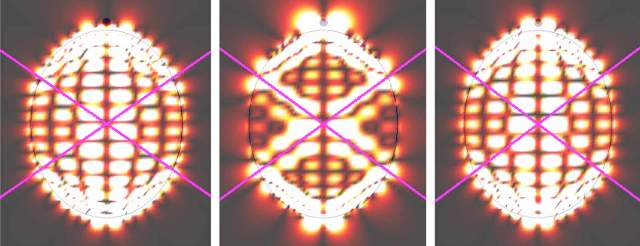A research team from the University of California, San Diego, has demonstrated that light can be trapped inside nanoscale granules of hexagonal boron nitride, a crystalline material that has fascinated researchers. The team was led by physics professor Michael Fogler.
 Patterns of orbiting light predicted for spheroids of hexagonal boron nitride illuminated with a dipole source just above their north poles. These are false-color plots of predicted hot spots of enhanced electrical fields. Magenta lines trace the periodic orbits on the surfaces set up by particular frequencies. Credit: Fogler group, UC San Diego.
Patterns of orbiting light predicted for spheroids of hexagonal boron nitride illuminated with a dipole source just above their north poles. These are false-color plots of predicted hot spots of enhanced electrical fields. Magenta lines trace the periodic orbits on the surfaces set up by particular frequencies. Credit: Fogler group, UC San Diego.
Hexagonal boron nitride comprises of stacked boron and nitrogen atoms arranged in the form of a hexagonal lattice. The material has been reported to be capable of bending electromagnetic energy in unique and potentially useful ways.
Fogler and his team discovered that light can be trapped inside nanoscale hexagonal boron nitride crystals last year. Now, a new paper has been published by the team in the Nano Letters journal describing the behaviour of the trapped light within the granules.
The light particles, known as phonon polaritons, do not follow the standard laws of reflection as they move through the granules, but their movement cannot be termed as random. According to Folger’s team, based on the material’s atomic structure, the polariton rays move along fixed angular paths. This behaviour can result in interesting resonances.
The trajectories of the trapped polariton rays are very convoluted in most instances. However, at certain ‘magic’ frequencies they can become simple closed orbits.
Michael Fogler, Professor of Physics, University of California
When that takes place, “hot spots” of significantly improved electrical fields can arise. Fogler’s team discovered that these are capable of creating detailed geometric patterns in spheroidal shape granules.
The polaritons can be thought of not just as particles, but also as waves that form interference patterns. They form amazing images when they are overlaid on the hot contours of improved electrical fields.
“They resemble Fabergé eggs, the gem-encrusted treasures of the Russian tsars,” Fogler observed.
Besides generating beautiful images, the analysis of polaritons shows the manner by which light is trapped in the material. The shape of the spheroid (i.e., its girth to length ratio), not its size, is used to determine the magical frequencies and the patterns. The analysis showed that the fixed angle, along which the polariton rays move with regards to the spheroid surface, is determined by a single parameter.
Scientists are now exploring potential applications for materials like hexagonal boron nitride, which are capable of bending light in unique ways. The theory derived from this research could form a basis for the development of applications such as infrared photon sources, nanoresonators for high-resolution spectral imaging and colour filtering, and hyperlenses for subdiffractional imaging.
The theory behind the earlier observations of trapped light is detailed in this research work. Fogler and his team suggested a number of experiments which could validate their prediction of orbiting light by means of sophisticated optical methods, some of which are in progress, Fogler said.
The experimental quest to detect orbiting polaritons has already begun.
Michael Fogler, Professor of Physics, University of California
The other authors include Zhiyuan Sun, a graduate student in Fogler's research group, Angel Guttiérrez-Rubio of the Spanish National Research Council (CSIC) who contributed to the project while a visiting scholar at UC San Diego, and Dimitri Basov, a professor of physics at UC San Diego.
The research work was supported by the UC Office of the President, U.S. Department of Energy, Spanish Ministry of Economy and Competitiveness, and European Research Council.